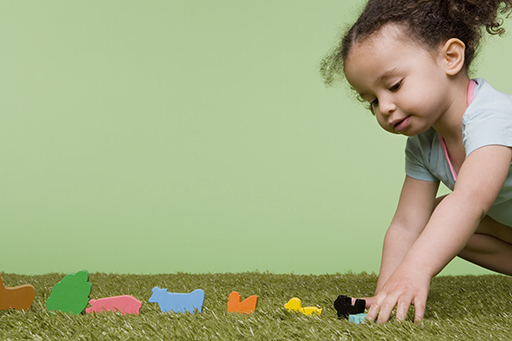1 Learning to play: schema
Chris Athey was a lecturer in education in the UK who noticed that children sometimes engage in repetitive actions, such as filling and emptying containers, lining objects up in rows or hiding items away. These repeated actions are known as ‘schemas’ and Athey defined them as ‘a pattern of repeatable behaviour into which experiences are assimilated and that are gradually co-ordinated’ (Athey, 1990, p. 37). Her work built upon the work of Piaget, who you read about in Week 2. He identified schemas as a means that a child uses to make sense of their world and construct their knowledge. A range of observable schemas have been identified from this basis.
The picture above shows an example of a transporting schema – the child is piling the blocks up and moving them around. The table below provides information that helps us identify the characteristics of a transporting schema. [Tip: hold Ctrl and click a link to open it in a new tab. (Hide tip)]
(If you’d like to find examples of each schema the further resources section at the end of this week provides a link.)
Children can demonstrate their schemas in many different ways, including how they move their bodies, how they use resources and how they interact with apparatus. Thomas (2021) suggests that having an informed knowledge of schemas can provide practitioners with a ‘window into a child’s world’ (p. 110) that can be used to provide children with resources and activities that support their schema(s), helping to maximise their learning opportunities.
Activity 1 Identifying schemas
Based on the schema descriptions in the table above, what schema do you think is being demonstrated in this picture?
Discussion
This shows a positioning schema, where the child has ordered wooden farm animals and arranged them into a row.
If you work in an early years setting in Wales you will probably have seen the A Curriculum for Funded Non-maintained Nursery Settings (Welsh Government, 2022) which contains information about how to use children’s schemas as a basis for planning for learning, and outlines the role of the adult in supporting learning and development.

This approach requires practitioners to take a more open approach to planning which is less focused on targets or skill outcomes. This approach still requires an element of recording what happens during play interactions in order to inform decisions about children’s future learning experiences – everything is not completely spontaneous and improvised. You will find out more about this in Week 6.


